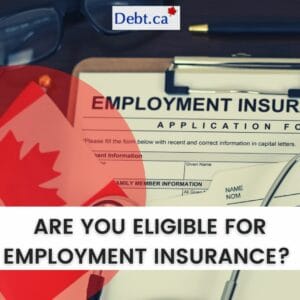Financial problems can be stressful, especially during uncertain economic times when job loss becomes a real possibility. A little preparation can help protect your well-being and reduce anxiety. Here’s a step-by-step guide to help you safeguard your financial health if you lose your job in Canada.
Rights and entitlements
You have important rights under Canadian employment laws if you are let go from your job. Both the federal and provincial/territorial governments set these laws.
Notice period
If your employer decides to end your employment, they must usually give you written notice or pay instead of notice. The amount of notice depends on how long you have worked for the company. If you have worked for at least three months, laws entitle you to at least two weeks’ notice, or pay instead of notice.
Severance pay
Once you’ve worked for an employer for a certain period of time, laws entitle you to severance pay in addition to notice or pay in lieu. Severance pay is extra money to help you while you look for a new job. The exact rules about severance pay depend on your province and how long you have worked at that organization.
Vacation pay
When your job ends, you are entitled to any unused vacation pay. Vacation pay is calculated as a percentage of your wages and must be paid to you within a certain timeframe after your employment ends.
Wage Earner Protection Program (WEPP)
The Wage Earner Protection Program (WEPP) is a Canadian government program that helps workers who’ve lost their jobs because their employer has gone bankrupt or is in receivership. It protects employees when companies cannot pay what they owe their employees. WEPP may cover any owed wages, vacation pay, termination pay, or severance pay from an employer who can’t pay. You need to apply after a trustee or receiver is named to handle your employer’s case. There is a yearly maximum payment limit, all of which is taxable.
Wrongful dismissal
If you believe your rights have been violated, such as being fired without notice or not receiving proper pay, you may have a case for wrongful dismissal. In these situations, it is a good idea to consult an employment lawyer for advice and support.
Employment Insurance (EI)
Employment Insurance (EI) is a Government of Canada program available to help people who have lost their jobs through no fault of their own. EI provides temporary financial support while you look for new work or upgrade your skills. It is an important safety net for many Canadians, especially during tough economic times.
Eligibility
To qualify for EI, you must have worked a certain number of hours in the past year, which can vary depending on where you live and the local unemployment rate. EI only covers those people who’ve lost their jobs for reasons beyond their control, such as layoffs or company closures. It doesn’t cover those who quit or are fired for misconduct. Additionally, you must be actively looking for a new job and able to work.
How to apply
You can apply for EI online through the Government of Canada website. You will need to provide personal information, details about your previous job, and your Record of Employment (ROE) from your employer. It’s important to apply as soon as you stop working, even if you don’t have your ROE yet.
Benefit amount
The amount you receive from EI is usually 55% of your average weekly earnings, up to a maximum set by the government. Payments are made every two weeks and are meant to help cover your basic expenses while you search for work.
Avoid financial problems by being prepared
There are several steps you can take to protect yourself and your family from unexpected financial problems. Here are some key tips to get started.
- Building an emergency fund is essential. Try to save enough money to cover at least three to six months of your basic living expenses. This fund will help you handle sudden, unexpected costs without falling into financial problems.
- Create a budget and review your expenses regularly. Track where your money goes each month and look for areas where you can cut back. This will help you manage your spending and save more each month.
- Debt management is another important step. Focus on paying off high-interest debts first, like credit cards. Avoid taking on new debt unless it is absolutely necessary. If you need to borrow money, a line of credit usually has a lower interest rate than a credit card, making it a better option.
- If you’re struggling to make payments, look into debt management plans, debt consolidation, negotiate a payment plan or a deferral option with the lender.
- Save instead of spending extra money, like pay bonuses and tax refunds. These extra funds can boost your emergency savings or help pay down debt.
- Don’t forget about health insurance! Make sure you have coverage for medical emergencies. Many companies allow you to change group plan coverage to an individual plan when you leave the job. Individual plans cost more, but may be worth it for your peace of mind. Assess your situation, look into the cost and value offered, and shop around to compare.
- If you find yourself in serious trouble, look into emergency assistance or social assistance programs in your province.
Job readiness
Being job-ready is important, especially when facing financial problems or looking for new opportunities. The first step is to update your resume and LinkedIn profile. Make sure to include all your recent skills, experiences, and accomplishments. This helps employers see your value right away. You can also use the “Open to Work” feature on LinkedIn to let recruiters know you are looking for a job.
Consider earning certifications in your field. Certifications show employers that you have up-to-date knowledge and skills. There are many online courses available, some of which are free or low-cost. Websites like Coursera, LinkedIn Learning, and Udemy offer courses on a wide range of topics.
In Canada, both provincial and federal governments offer programs to help people upskill or retrain. For example, the Canada Job Grant and provincial employment centres provide funding and support for training. These programs can help you learn new skills that are in demand.
Finally, don’t forget the importance of networking. Connect with people in your industry, attend job fairs, and join professional groups. Networking can lead to job leads and valuable advice. By taking these steps, you can improve your job readiness and increase your chances of finding work.
Key takeaways
Losing a job can create serious financial problems. Knowing your rights and being prepared can help. If you lose your job through no fault of your own, you may be entitled to Employment Insurance (EI), which provides temporary income while you look for new work. Make sure you apply for EI as soon as possible after losing your job. It’s also a good idea to review your employment contract and talk to your employer about any severance pay or benefits you might receive.
Staying job-ready is important too, so keep your resume updated, practice interview skills, and look for training opportunities to improve your chances of finding new work quickly. Being financially prepared can help you be less stressed while you handle the situation. Try to save money when you are working, and create a budget to manage your expenses if you lose your job. If you’re currently dealing with debt, contact one of our trained credit counsellors for advice on which debt relief strategy could be the right fit for your situation and finances.










